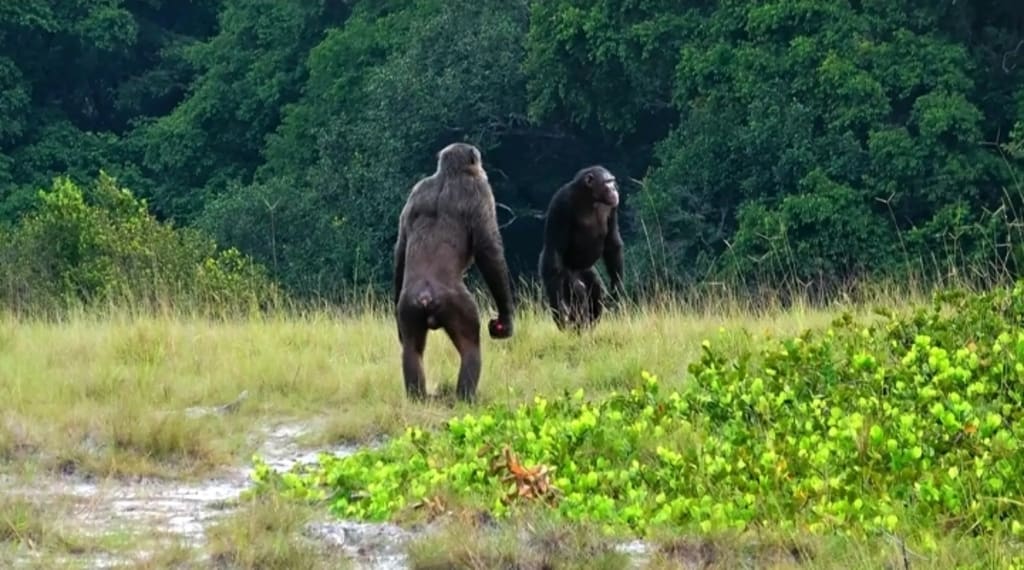Chimpanzees and Gorillas have seen going to War for the first time -Scientist Revealed
Exploring the Dynamics of Violence Among Chimpanzees and Gorillas: Insights into Primate Behavior and Human Evolution

Wild animals exhibit behaviors distinct from humans, particularly in their motivations for harming others. Unlike humans, wild animals primarily resort to harming others for self-defense rather than out of spite or greed, a characteristic long observed in their natural interactions. However, recent findings suggest a potential shift in this established behavior pattern. Despite these differences, wild animals share a common drive for survival and reproduction, crucial for the continuation of their species. This fundamental instinct shapes their actions as they navigate the challenges posed by their natural environments.
Scientific research has brought to light a previously unseen phenomenon: violent altercations among chimpanzees and gorillas, our closest relatives in the animal kingdom. These primates, sharing a significant genetic similarity with humans, have been observed engaging in behaviors indicative of aggression towards one another. The revelation of such confrontations challenges conventional understandings of primate behavior, especially among species considered close relatives to humans. The occurrence of violence among these animals raises intriguing questions regarding the underlying motivations and triggers for such behavior.
Chimpanzees and gorillas have garnered considerable scientific interest due to their potential insights into human evolution and behavior. The discovery of aggression between these primates offers a fresh perspective on the complexities of social dynamics within animal communities. A recent incident within a national park serves as a notable example of this newfound behavior among chimpanzees and gorillas. Observations made by researchers provide compelling evidence of physical confrontations between members of these primate species.
The implications of such behavior extend beyond the realm of animal behavior studies, touching upon broader questions regarding the nature of aggression and conflict within social groups. Understanding the mechanisms driving intergroup violence among primates offers valuable insights into human societal dynamics as well. It is essential to approach these findings with a nuanced understanding of animal behavior, recognizing that complex interactions and motivations underlie seemingly straightforward actions.
While violence among wild animals may challenge certain preconceptions, it also underscores the intricate nature of life in the natural world. Continued research into the behavior of chimpanzees and gorillas, as well as other primates, promises to yield further insights into the evolutionary roots of human behavior. By studying the behaviors of our closest animal relatives, scientists gain a deeper understanding of the factors shaping human sociality and conflict resolution.
In summary, the observation of violent encounters between chimpanzees and gorillas introduces a new dimension to our understanding of animal behavior. These discoveries highlight the dynamic nature of life in the wild and emphasize the importance of ongoing scientific inquiry into the behaviors of non-human primates. Through diligent study and observation, researchers can unravel the complexities of primate behavior, shedding light on the evolutionary pathways that have shaped both human and animal societies.
The emergence of violence among chimpanzees and gorillas challenges previous assumptions about the peaceful nature of wild animals' interactions. While traditionally believed to primarily engage in aggressive behaviors for protection rather than out of spite or greed, these recent observations suggest a more complex reality. This newfound understanding prompts a reevaluation of existing theories regarding primate behavior and necessitates further exploration into the motivations driving such confrontations.
The significance of these findings extends beyond the realm of academic curiosity, impacting conservation efforts and wildlife management strategies. Understanding the factors contributing to intergroup violence among primates is essential for promoting peaceful coexistence within their natural habitats. Moreover, insights gleaned from studying primate behavior have broader implications for human society, offering valuable lessons in conflict resolution and social dynamics.
In conclusion, the revelation of violent altercations among chimpanzees and gorillas challenges long-held assumptions about the peaceful nature of wild animal interactions. This discovery underscores the complexity of primate behavior and emphasizes the need for continued research to unravel the underlying motivations and mechanisms driving such confrontations. By deepening our understanding of non-human primate behavior, we gain valuable insights into both the evolutionary origins of human behavior and effective strategies for wildlife conservation.






Comments
There are no comments for this story
Be the first to respond and start the conversation.